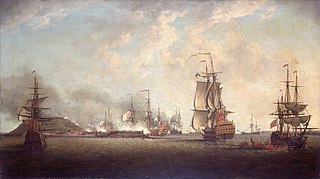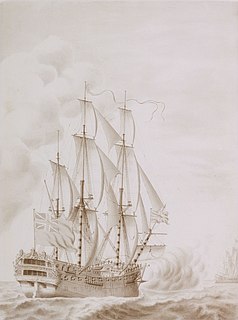
HMS Warspite was one of five Queen Elizabeth-class battleships built for the Royal Navy during the early 1910s. Completed during the First World War in 1915, she was assigned to the Grand Fleet and participated in the Battle of Jutland. Other than that battle, and the inconclusive Action of 19 August, her service during the war generally consisted of routine patrols and training in the North Sea. During the interwar period the ship was deployed in the Atlantic Ocean and the Mediterranean Sea, often serving as flagship, and was thoroughly modernised in the mid-1930s.

Scipion was a 74-gun French ship of the line, built at Lorient to a design by Jacques Noel Sane. She was launched as Orient in late 1798, and renamed Scipion in 1801. She was first commissioned in 1802 and joined the French Mediterranean fleet based at Toulon, in the squadron of Admiral Leissègues. Consequently she was one of the ships afloat in that port when war with England reopened in May 1803. She participated in the Battle of Cape Finisterre and the Battle of Trafalgar. The British captured her in the subsequent Battle of Cape Ortegal. In 1810 she participated in the Java campaign, which in 1847 earned her surviving crew the Naval General Service Medal. She participated in the blockade of Toulon in 1813 and was paid off in 1814. She was broken up in 1819.

HMS Arrogant was a 74-gun third rate ship of the line of the Royal Navy, built of Suffolk oak launched on 22 January 1761 at King's Yard Harwich. She was the first of the Arrogant-class ships of the line, designed by Sir Thomas Slade.

HMS Superb was a 74-gun Bellona-class third-rate ship of the line of the Royal Navy, launched on 27 October 1760 at Deptford Dockyard.

HMS Ocean was a 90-gun second rate ship of the line of the Royal Navy, launched on 21 April 1761 at Chatham.

HMS Duke was a 90-gun second-rate ship of the line of the Royal Navy, launched on 13 June 1682 at Woolwich Dockyard.

HMS Warspite was a 74-gun third-rate ship of the line of the Royal Navy, launched in 1807. She served in the Napoleonic Wars and was decommissioned in 1815. After conversion to a 76-gun ship in 1817 she circumnavigated the world, visiting Australia. She was cut down to a single decker 50-gun frigate in 1840 and was decommissioned in 1846. She was lent as a boys' training ship to The Marine Society and was lost to fire in 1876.

HMS Ardent was a 64–gun third-rate ship of the line of the Royal Navy, launched on 9 April 1796 at Northfleet. She had been designed and laid down for the British East India Company who was going to name her Princess Royal, but the Navy purchased her before launching, for service as a warship in the French Revolutionary War.

HMS Warspite was a 70-gun third-rate ship of the line of the Royal Navy, launched in 1666 at Blackwall Yard. This second Warspite was one of the five ships designed to carry more provisions and lower deck guns higher above the water than French and Dutch equivalents. In 1665 the Second Anglo-Dutch War had begun and on 25 July 1666 Warspite was one of 23 new English warships helping to beat a Dutch fleet off North Foreland, Kent. She won again distinction on Christmas Day 1666 as senior officer's ship out of five sent to protect an important convoy of naval stores from the Baltic. Warspite next took part in the first action of the Third Anglo-Dutch War on 28 May 1672 off Southwold Bay, Suffolk. This desperate 14-hour battle, generally known as Solebay, was a drawn fight; but Warspite successfully fended off a pair of Dutch fire ships exactly as she had done off North Foreland. By 1685, she was mounting only 68 guns.

Téméraire was a 74-gun ship of the line of the French Navy, ordered in December 1747 to a design by François Coulomb, and built at Toulon by his cousin, the constructor Pierre-Blaise Coulomb; she was launched on 24 December 1749. Her 74 guns comprised:
28 x 36-pounders on the lower deck
30 x 18-pounders on the upper deck
10 x 8-pounders on the quarterdeck
6 x 8-pounders on the forecastle.

Warspite was a great ship of the English Tudor navy. The vessel was built at Deptford Dockyard by the master shipwright Edward Stevens and launched about 1 March 1596. She carried a crew of 300 when at sea, of whom 190 were classed as "mariners", manning the guns and fighting the ship; 80 as "sailors", working the sails and ancestors of present-day seamen and 30 "gunners", the armament specialists.

HMS Neptune was a 90-gun second-rate ship of the line of the Royal Navy. She was built under the 1677 "Thirty Great Ships" Programme and launched in 1683 at Deptford Dockyard.
HMS Burford was a 70-gun third rate ship of the line of the Royal Navy, launched at Woolwich Dockyard in 1679 as part of the Thirty Ships Programme of 1677. She fought in the War of English Succession, including the Battle of Barfleur, before being rebuilt at Deptford in 1699, remaining as a 70-gun third rate. During the War of Spanish Succession she was mostly in the Mediterranean fleet and fought at the capture of Gibraltar and the Battle of Málaga in 1704 before being extensively repaired between 1710 and 1712 at Portsmouth Dockyard. Burford served in the Baltic in 1715 and 1717 before returning to the Mediterranean to fight the Spanish at the Battle of Cape Passaro in 1718. She was wrecked on the Italian coast in a storm on 14 February 1719.

HMS Swiftsure was a 70-gun third-rate ship of the line of the Royal Navy, launched in 1755 and in active service during the Seven Years' War. After a distinguished career at sea she was decommissioned in 1763 and sold into private hands ten years later.
HMS Falmouth was a 50-gun fourth rate ship of the line built for Royal Navy in the 1690s. The ship participated in several battles during the Nine Years' War of 1688–97 and the War of the Spanish Succession (1701–1715), including the action of August 1702. She was captured by the French in 1704.

HMS Burford was a 70-gun third rate ship of the line of the Royal Navy, built at Deptford Dockyard to the 1719 Establishment, and launched on 19 July 1722. Burford was notably the early posting of both John Forbes and John Byng, both of whom rose to become Admirals.

HMS Stirling Castle was a 70-gun third rate ship of the line of the Royal Navy, built at Chatham Dockyard to the 1733 proposals of the 1719 Establishment, and launched on 24 April 1742.

HMS Tiger or Tygre was a 60-gun fourth rate ship of the line of the Royal Navy, built at Rotherhithe to the draught specified by the 1745 Establishment and launched on 23 November 1747.
HMS Burford was a 70-gun third rate ship of the line of the Royal Navy, built at Chatham Dockyard to the draught specified by the 1745 Establishment as amended in 1754, and launched in 1757.

HMS Victory is a 104-gun first-rate ship of the line of the Royal Navy, ordered in 1758, laid down in 1759 and launched in 1765. She is best known for her role as Lord Nelson's flagship at the Battle of Trafalgar on 21 October 1805.


















